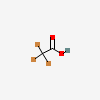Tribromoacetic Acid
- Tribromoacetic acid
- 75-96-7
- 2,2,2-tribromoacetic acid
- Acetic acid, tribromo-
- Tribromacetic acid
- Create:2005-03-26
- Modify:2025-01-18

- tribromoacetate
- tribromoacetic acid
- Tribromoacetic acid
- 75-96-7
- 2,2,2-tribromoacetic acid
- Acetic acid, tribromo-
- Tribromacetic acid
- CCRIS 7887
- UNII-71KTL99QJX
- EINECS 200-919-9
- 71KTL99QJX
- DTXSID6021668
- Acetic acid, 2,2,2-tribromo-
- HSDB 7623
- DTXCID301668
- TRIBROMOACETIC ACID [MI]
- TRIBROMOACETIC ACID [HSDB]
- C2HBr3O2
- Acetic acid, tribromo
- Tribromoaceticacid-methylt.
- 2,2,2Tribromoacetic acid
- Tribromoacetic acid, 99%
- Acetic acid, 2,2,2tribromo
- SCHEMBL210187
- CHEMBL502627
- Tox21_200913
- MFCD00004167
- STL089890
- AKOS005655320
- FS-4203
- CAS-75-96-7
- Tribromoacetic acid, analytical standard
- NCGC00188893-01
- NCGC00188893-02
- NCGC00258467-01
- DB-056003
- NS00007316
- T0351
- D95394
- EN300-143018
- W-104381
- Q20978596

P260, P264, P280, P301+P330+P331, P302+P361+P354, P304+P340, P305+P354+P338, P316, P321, P363, P405, and P501
(The corresponding statement to each P-code can be found at the GHS Classification page.)
Aggregated GHS information provided per 47 reports by companies from 4 notifications to the ECHA C&L Inventory.
Information may vary between notifications depending on impurities, additives, and other factors. The percentage value in parenthesis indicates the notified classification ratio from companies that provide hazard codes. Only hazard codes with percentage values above 10% are shown.
Patents are available for this chemical structure:
https://patentscope.wipo.int/search/en/result.jsf?inchikey=QIONYIKHPASLHO-UHFFFAOYSA-N
- CAS Common ChemistryLICENSEThe data from CAS Common Chemistry is provided under a CC-BY-NC 4.0 license, unless otherwise stated.https://creativecommons.org/licenses/by-nc/4.0/Tribromoacetic acidhttps://commonchemistry.cas.org/detail?cas_rn=75-96-7
- ChemIDplusTribromoacetic acidhttps://pubchem.ncbi.nlm.nih.gov/substance/?source=chemidplus&sourceid=0000075967ChemIDplus Chemical Information Classificationhttps://pubchem.ncbi.nlm.nih.gov/source/ChemIDplus
- EPA Chemicals under the TSCAAcetic acid, 2,2,2-tribromo-https://www.epa.gov/chemicals-under-tscaEPA TSCA Classificationhttps://www.epa.gov/tsca-inventory
- EPA DSSToxTribromoacetic acidhttps://comptox.epa.gov/dashboard/DTXSID6021668CompTox Chemicals Dashboard Chemical Listshttps://comptox.epa.gov/dashboard/chemical-lists/
- European Chemicals Agency (ECHA)LICENSEUse of the information, documents and data from the ECHA website is subject to the terms and conditions of this Legal Notice, and subject to other binding limitations provided for under applicable law, the information, documents and data made available on the ECHA website may be reproduced, distributed and/or used, totally or in part, for non-commercial purposes provided that ECHA is acknowledged as the source: "Source: European Chemicals Agency, http://echa.europa.eu/". Such acknowledgement must be included in each copy of the material. ECHA permits and encourages organisations and individuals to create links to the ECHA website under the following cumulative conditions: Links can only be made to webpages that provide a link to the Legal Notice page.https://echa.europa.eu/web/guest/legal-noticeTribromoacetic acidhttps://echa.europa.eu/substance-information/-/substanceinfo/100.000.837Tribromoacetic acid (EC: 200-919-9)https://echa.europa.eu/information-on-chemicals/cl-inventory-database/-/discli/details/61906
- FDA Global Substance Registration System (GSRS)LICENSEUnless otherwise noted, the contents of the FDA website (www.fda.gov), both text and graphics, are not copyrighted. They are in the public domain and may be republished, reprinted and otherwise used freely by anyone without the need to obtain permission from FDA. Credit to the U.S. Food and Drug Administration as the source is appreciated but not required.https://www.fda.gov/about-fda/about-website/website-policies#linkingTRIBROMOACETIC ACIDhttps://gsrs.ncats.nih.gov/ginas/app/beta/substances/71KTL99QJX
- Hazardous Substances Data Bank (HSDB)TRIBROMOACETIC ACIDhttps://pubchem.ncbi.nlm.nih.gov/source/hsdb/7623
- ChEMBLLICENSEAccess to the web interface of ChEMBL is made under the EBI's Terms of Use (http://www.ebi.ac.uk/Information/termsofuse.html). The ChEMBL data is made available on a Creative Commons Attribution-Share Alike 3.0 Unported License (http://creativecommons.org/licenses/by-sa/3.0/).http://www.ebi.ac.uk/Information/termsofuse.html
- Crystallography Open Database (COD)LICENSEAll data in the COD and the database itself are dedicated to the public domain and licensed under the CC0 License. Users of the data should acknowledge the original authors of the structural data.https://creativecommons.org/publicdomain/zero/1.0/
- The Cambridge Structural Database
- Drug Gene Interaction database (DGIdb)LICENSEThe data used in DGIdb is all open access and where possible made available as raw data dumps in the downloads section.http://www.dgidb.org/downloadsTRIBROMOACETIC ACIDhttps://www.dgidb.org/drugs/chembl:CHEMBL502627
- EPA Pesticide Ecotoxicity Database
- Haz-Map, Information on Hazardous Chemicals and Occupational DiseasesLICENSECopyright (c) 2022 Haz-Map(R). All rights reserved. Unless otherwise indicated, all materials from Haz-Map are copyrighted by Haz-Map(R). No part of these materials, either text or image may be used for any purpose other than for personal use. Therefore, reproduction, modification, storage in a retrieval system or retransmission, in any form or by any means, electronic, mechanical or otherwise, for reasons other than personal use, is strictly prohibited without prior written permission.https://haz-map.com/AboutTribromoacetic acidhttps://haz-map.com/Agents/21645
- IUPAC Digitized pKa Datasetacetic acid, tribromo-https://github.com/IUPAC/Dissociation-Constants
- Japan Chemical Substance Dictionary (Nikkaji)
- NIST Mass Spectrometry Data CenterLICENSEData covered by the Standard Reference Data Act of 1968 as amended.https://www.nist.gov/srd/public-lawTribromoacetic acidhttp://www.nist.gov/srd/nist1a.cfm
- SpectraBaseTRIBROMOACETIC ACIDhttps://spectrabase.com/spectrum/IsB3kkArirwTribromoacetic acidhttps://spectrabase.com/spectrum/GEzTwYwM4attribromoacetic acidhttps://spectrabase.com/spectrum/FSbSXQCyoPFTRIBROMOACETIC ACIDhttps://spectrabase.com/spectrum/Ds9jAIU6hv6Tribromoacetic acidhttps://spectrabase.com/spectrum/HewaksuJn5VTribromoacetic acidhttps://spectrabase.com/spectrum/fAt4wPT2kxTribromoacetic acidhttps://spectrabase.com/spectrum/6bXt61uVO5bTribromoacetic acidhttps://spectrabase.com/spectrum/563PoLYWIJu
- Springer Nature
- SpringerMaterialsAcetic acid, tribromo-https://materials.springer.com/substanceprofile/docs/smsid_puucxomefohrtozw
- Thieme ChemistryLICENSEThe Thieme Chemistry contribution within PubChem is provided under a CC-BY-NC-ND 4.0 license, unless otherwise stated.https://creativecommons.org/licenses/by-nc-nd/4.0/
- Wikidatatribromoacetic acidhttps://www.wikidata.org/wiki/Q20978596
- WikipediaFluoroethyl-L-tyrosine (18F)https://en.wikipedia.org/wiki/Fluoroethyl-L-tyrosine_(18F)Tribromoacetic acidhttps://en.wikipedia.org/wiki/Tribromoacetic_acid
- PubChem
- Medical Subject Headings (MeSH)LICENSEWorks produced by the U.S. government are not subject to copyright protection in the United States. Any such works found on National Library of Medicine (NLM) Web sites may be freely used or reproduced without permission in the U.S.https://www.nlm.nih.gov/copyright.htmltribromoacetic acidhttps://www.ncbi.nlm.nih.gov/mesh/67017766
- GHS Classification (UNECE)GHS Classification Treehttp://www.unece.org/trans/danger/publi/ghs/ghs_welcome_e.html
- NORMAN Suspect List ExchangeLICENSEData: CC-BY 4.0; Code (hosted by ECI, LCSB): Artistic-2.0https://creativecommons.org/licenses/by/4.0/NORMAN Suspect List Exchange Classificationhttps://www.norman-network.com/nds/SLE/
- EPA Substance Registry ServicesEPA SRS List Classificationhttps://sor.epa.gov/sor_internet/registry/substreg/LandingPage.do
- MolGenieMolGenie Organic Chemistry Ontologyhttps://github.com/MolGenie/ontology/
- PATENTSCOPE (WIPO)SID 403417188https://pubchem.ncbi.nlm.nih.gov/substance/403417188

